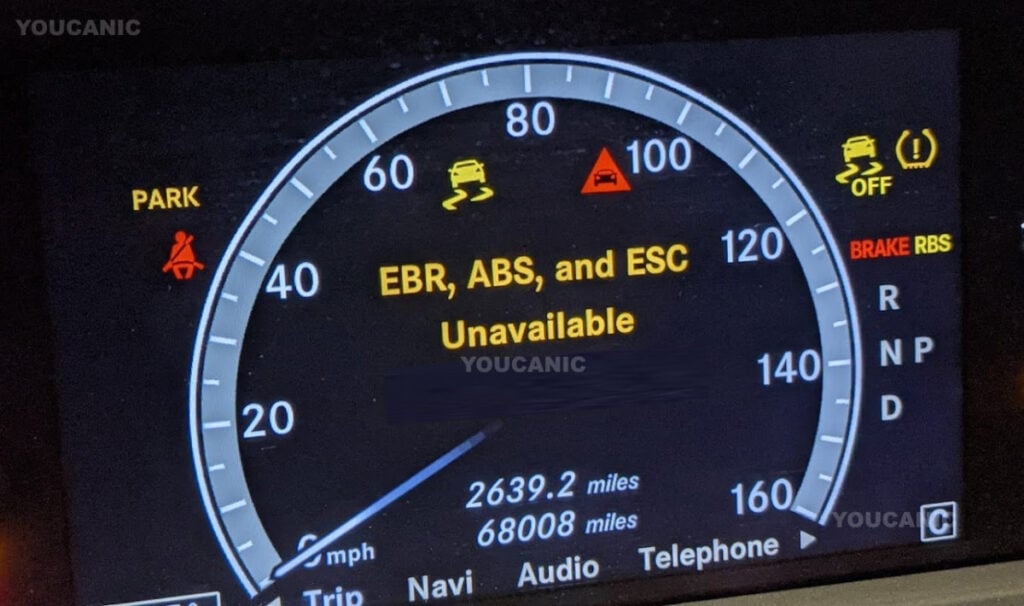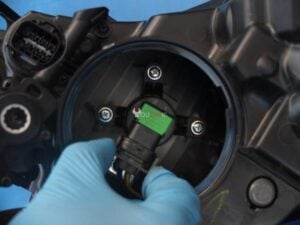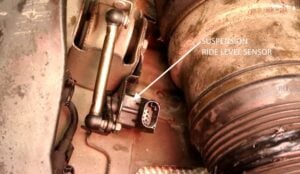How to Find Why ABS Light On
Is your ABS light on? A faulty ABS wheel speed sensor is the most common problem that triggers the ABS light to come on, along with traction and stability control warnings. There is one ABS wheel speed sensor at each wheel of the vehicle. Once one ABS sensor fails, the ABS light comes on; plus, if the vehicle has traction control and stability control, these systems will also be disabled.
How to Troubleshoot ABS Light On

The ABS stands for Anti-lock Brake System. ABS is one of a modern car’s most significant safety features. Since its introduction in the 70s, this system has prevented countless accidents and saved many lives.
The wheels on a car can lock up when braking on slippery surfaces, such as when the road is wet or covered with snow. When that happens, the car will lose traction and start skidding, which elongates its brake distance and makes it difficult to control. To prevent this, the ABS will shortly cut the brake force on skidding wheels, allowing them to regain grip. When the anti-lock brakes activate, the driver can notice the brake pedal pulsating sharply and quickly.
If ABS malfunctions, the vehicle will warn the driver by triggering an ABS warning. Also, traction control and stability lights will come on if present.
What causes the ABS light to come on?

As stated previously, one of the most common problems that trigger the ABS light to come on is a faulty ABS wheel speed sensor.
Other issues that can trigger the ABS indicator light to come on include:

- Faulty ABS wheel speed sensor
- Low battery voltage
- Steering angle sensor
- Defective Yaw Sensor
- ABS pump
- Damaged wire harness
- The ABS module won’t communicate
The Christian Brothers Automotive gives a shorter list of the top four reasons your ABS light can come on.
If your check engine light is on, it’s probably unrelated to the ABS failure. Worn brake pads do not turn on the ABS light.
In this article, we’ll find out what might be causing the ABS light to illuminate and what to do when this happens.
ABS light meaning

When your car’s ABS light comes on, there is a problem with your vehicle’s anti-lock braking system.
While you can still drive the car, it is recommended to fix the issue as soon as possible; otherwise, it could make your car unsafe to drive, especially in extreme driving conditions. ABS prevents the wheels from locking up when braking to improve braking distance. The majority of pre-2010 vehicles did not have ABS brake systems at all.

The ABS, as well as the Traction and Stability control systems, are complex and elaborate systems. As such, these safety systems need all of their components to function in perfect harmony and work properly. Even the slightest failure, such as an implausible signal from the speed sensor, might bring the multiple safety systems down.
When that happens, the ABS and corresponding safety features won’t be able to kick in when the tires lock up or lose grip. So, to warn the driver, the vehicle will trigger an ABS light on its dashboard. Otherwise, drivers wouldn’t know the issue until their car starts sliding while braking or loses traction in slow or hard cornering.
Is it safe to drive if the ABS light comes on?

If your ABS light comes on, you can carefully drive to your destination as long as the red brake light is off and your brakes still work.
Warning
Stop the car and check the brake fluid level to ensure you are not losing brake fluid. Do not drive if the brakes don’t work or you have lost brake fluid.
Drive carefully, as your ABS will not respond in an emergency, which means that if the road is slippery or you brake due to an emergency, the wheels may lock up, and the vehicle may skid.
If the BRAKE warning light is on, bring your car to a stop and do not drive it without consulting an auto mechanic.
While driving a car with an ABS light on is possible, it’s safer to drive a car with working ABS, stability control, and traction control.
Reset the Anti-Lock Brake System warning light.
So your ABS light is on, and if your car has traction and stability control, those lights are on, too. The dashboard can light up like a Christmas tree from a faulty ABS sensor if you have a newer vehicle.
In this tutorial, we will show you how to find out why your ABS and stability control lights are on. We have found that in 8 out of 10 cases, the problem is due to a bad speed sensor. The car has four sensors, and without a tool, there is no way of knowing which one is bad.
We often see owners replace all four ABS sensors in hopes of fixing the issue. This approach sometimes works, but it often doesn’t because the sensors might be elsewhere. In addition, you are spending money and time replacing a perfectly working ABS wheel speed sensor. It is rare for more than one sensor to fail at a time, let alone all four.
To find out why your ABS and stability control lights are on, we will run a full vehicle scan, which shows all the codes and gives us a general idea about the vehicle’s health. For this procedure, we will be utilizing the YOUCANIC full system scanner.
- Locate the OBD-II port under the dashboard and plug in the YOUCANIC scanner.
- Turn on the ignition, but don’t start the engine. To do this, you must press START/STOP several times without pressing the brake pedal.
- Turn on the scanner and select your vehicle.
- Next, you need to select your specific vehicle model and year.
- Run a full system scan to get a list of all the codes. This scanner alone can give you an idea of why your ABS light stays on. If not, continue to the next step.
- Go back and select Control Units from the previous screen.
- Select Control Units.
- Next, select the ABS module.
- Select Read Fault Codes.
A fault code will indicate which sensor is faulty and needs to be replaced. If you would like to confirm the error code, do the following:
- Select view Live Data.
- This displays the list of possible values to stream—select wheel speed sensors.
- Have a helper drive the vehicle while you monitor the display.
If it is defective, the ABS sensor will need to be replaced. This is the most common culprit that triggers the ABS light to come on. Those warning lights will also come on if the car has stability and traction control, which relies on the ABS for its operation.
Problems that Trigger ABS Light On
1. Bad speed sensors
The ABS uses speed sensors at each wheel to determine if they have stopped spinning. Their location inside the wheel hub exposes them to dirt, moisture, or damage from road debris. If this happens, it may offset or interrupt the sensors’ readings, consequently shutting down the ABS.
If one of the wheel speed sensors fails, the ABS light will come on. A bad ABS sensor will turn on many indicator lights, including the traction control and stability control lights, which will also turn on if the vehicle is equipped with those systems.
2. Damaged wheel reluctor ring
Some cars have an ABS reluctor ring within each wheel hub, from which the speed sensor picks up readings. With time, they may get rusty or bent out of shape, which affects the speed sensor signals. They might even scratch against the sensor and damage it if it is deformed enough.
3. Yaw Rate Sensor
A Yaw Rate Sensor (or rotational speed sensor) measures a vehicle’s angular speed about its vertical axis in degrees to determine its direction as it takes corners or as the vehicle tries to roll over.
The ABS module uses data from the Yaw rate sensor, and if the Yaw rate sensor is faulty ABS light will turn on. A faulty Yaw rate sensor may also trigger the airbag or SRS lights.
4. Broken ABS module
The ABS module is, in essence, an electronically controlled hydraulic pump. Its job is to regulate the flow of pressurized brake fluid coming from the brake master cylinder.
These modules, however, may malfunction, causing the ABS to become inoperable. In most cases, the problem will be either leaking solenoids or electronics, both of which are inside the module.
5. Wiring issues
Electrical and electronic systems have wiring that connects their components. Damaged wiring may lead to all sorts of issues, including interrupted power supply or signal interference. Lastly, a broken wire might cause a short circuit, which blows up a corresponding fuse.
6. Low brake fluid level
Despite its complexity, the ABS still relies on brake fluid to generate brake pressure, which does all the mechanical work. So, if the level inside the brake fluid reservoir is low, the ABS will probably stop working. Checking the fluid levels should be one of the first things to do if there are no other apparent causes.
Do brakes work when the ABS light is on?
If your car has it, the ABS and Stability control will only take action if it starts skidding or sliding. These safety devices will be on standby while closely monitoring all crucial parameters for the rest of the time.
Your car’s brakes will still work, even when the ABS warning light is on. If the wheels lock up while braking, there won’t be anything to help you regain control. The same is true with Stability control features, which sharpen the car when it starts sliding or drifting. So, if necessary, you can drive your car with the ABS light on, but be extra careful.
We urge you to fix any ABS problem as soon as possible for your sake and the safety of other motorists and pedestrians. The last thing you want is to crash into the car that stopped before you or slide into the ditch because your wheels have locked up.
What To Do If Your ABS Warning Light Comes On
If the ABS light is on, ensure the red BRAKE light does not come on. The dashboard will have a few other warning lights, such as a traction control light and stability control light, but don’t worry. These systems are disabled when the ABS doesn’t work.
Drive carefully to your destination. Do not go over the speed limit, and avoid hard braking and acceleration. You are driving a vehicle without ABS, traction control, and stability control, and if the vehicle loses traction, these systems will not intervene. It’s the same as driving a vehicle made in the pre-2000 area, as back then, these systems were very rare to find on a vehicle.
How much does it cost to fix the ABS light?
Once you reach your destination, take your car to an auto repair shop or get the YOUCANIC Full System Scanner and troubleshoot the problem yourself. Find out which ABS wheel speed sensor is bad ( the most likely cause) and replace it to fix the problem.
The ABS wheel speed sensor is mounted on the wheel hub and is very easy to replace in most cars. A new ABS wheel speed usually costs around $50 and can be replaced in under 30 minutes in your driveway. If you take your vehicle to the dealership, expect to pay around $400-$800 for repair that you can and should be able to fix on your driveway.
Frequently asked questions
What to do if my ABS light comes on?
First, drive moderately, paying more attention to road conditions than usual. While your brakes will still work fine, there won’t be anything to help you if the car starts sliding. So, you don’t want to find yourself in a situation that requires sudden braking and maneuvering. But still, try to find out what’s causing the issues and fix it as soon as possible.
How do I fix my ABS light?
You can always try turning the car off and then restarting it. Sometimes, the ABS light might stay on because of a glitch within the system and might go away after this reset. But if it stays on, you’ll have to diagnose a problem. You will need a scan tool to access the ABS control module. You can narrow down the problem and pinpoint the faulty part using it.
ABS warning light in short
The ABS, or Anti-lock Brake System, is a safety device that prevents the wheels from locking up when braking. It makes driving safer, especially when traveling on slippery roads. A big red ABS light will illuminate the dashboard if the system malfunctions. That should warn the driver this safety-critical feature is out of action.









